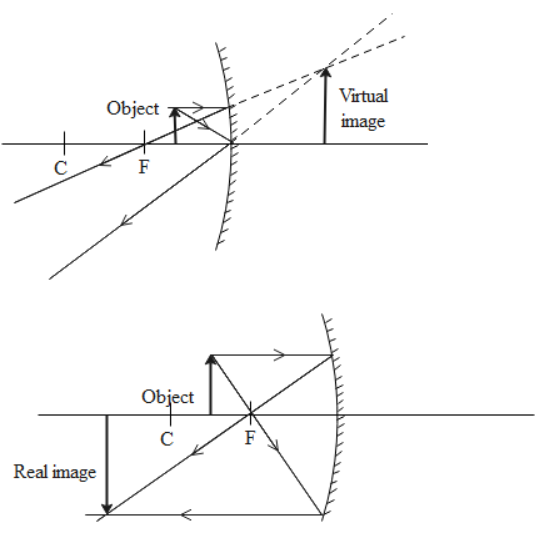
What is the nature of image formed by a concave mirror?
A. Real and inverted
B. Virtual and erect
C. Depends on the position of the object
D. Real and erect
Answer
588k+ views
Hint: When an object is placed very close to the convex mirror, then we obtain virtual images which cannot be obtained on a screen while if the object is kept away then real images are formed which can be obtained on a screen.
Complete step by step answer:
The two types of spherical mirror commonly used are concave mirror and convex mirror. They are made by polishing the inner or outer side of a curved glass. Convex mirror is made by polishing the outer curved surface while a concave mirror is made by polishing the inner curved surface.
In a concave mirror, due to the nature of the inner reflecting surface, the light rays incident on it tend to converge.
Image formation in concave mirrors depends on the distance of the object from the mirror.
When the object is positioned very close to the mirror, we obtain a virtual and magnified image. At larger distances from the mirror, the images formed are real and inverted.

Therefore, the correct answer should be option C as the nature of image depends on distance of object from the mirror
Note: The laws of reflection are valid at all points on the curved surface of a concave mirror as well as a convex mirror. The light rays converge in a concave mirror because the normal on the surface of the mirror is not the same at all points of the mirror and changes due to the curve of the mirror. Same reasoning is valid in the case of convex mirrors which diverge the incident light rays.
Complete step by step answer:
The two types of spherical mirror commonly used are concave mirror and convex mirror. They are made by polishing the inner or outer side of a curved glass. Convex mirror is made by polishing the outer curved surface while a concave mirror is made by polishing the inner curved surface.
In a concave mirror, due to the nature of the inner reflecting surface, the light rays incident on it tend to converge.
Image formation in concave mirrors depends on the distance of the object from the mirror.
When the object is positioned very close to the mirror, we obtain a virtual and magnified image. At larger distances from the mirror, the images formed are real and inverted.

Therefore, the correct answer should be option C as the nature of image depends on distance of object from the mirror
Note: The laws of reflection are valid at all points on the curved surface of a concave mirror as well as a convex mirror. The light rays converge in a concave mirror because the normal on the surface of the mirror is not the same at all points of the mirror and changes due to the curve of the mirror. Same reasoning is valid in the case of convex mirrors which diverge the incident light rays.
Recently Updated Pages
Master Class 10 General Knowledge: Engaging Questions & Answers for Success

Master Class 10 Computer Science: Engaging Questions & Answers for Success

Master Class 10 English: Engaging Questions & Answers for Success

Master Class 10 Social Science: Engaging Questions & Answers for Success

Master Class 10 Maths: Engaging Questions & Answers for Success

Master Class 10 Science: Engaging Questions & Answers for Success

Trending doubts
The shortest day of the year in India

Why is there a time difference of about 5 hours between class 10 social science CBSE

Write a letter to the principal requesting him to grant class 10 english CBSE

What is the median of the first 10 natural numbers class 10 maths CBSE

The Equation xxx + 2 is Satisfied when x is Equal to Class 10 Maths

State and prove converse of BPT Basic Proportionality class 10 maths CBSE




